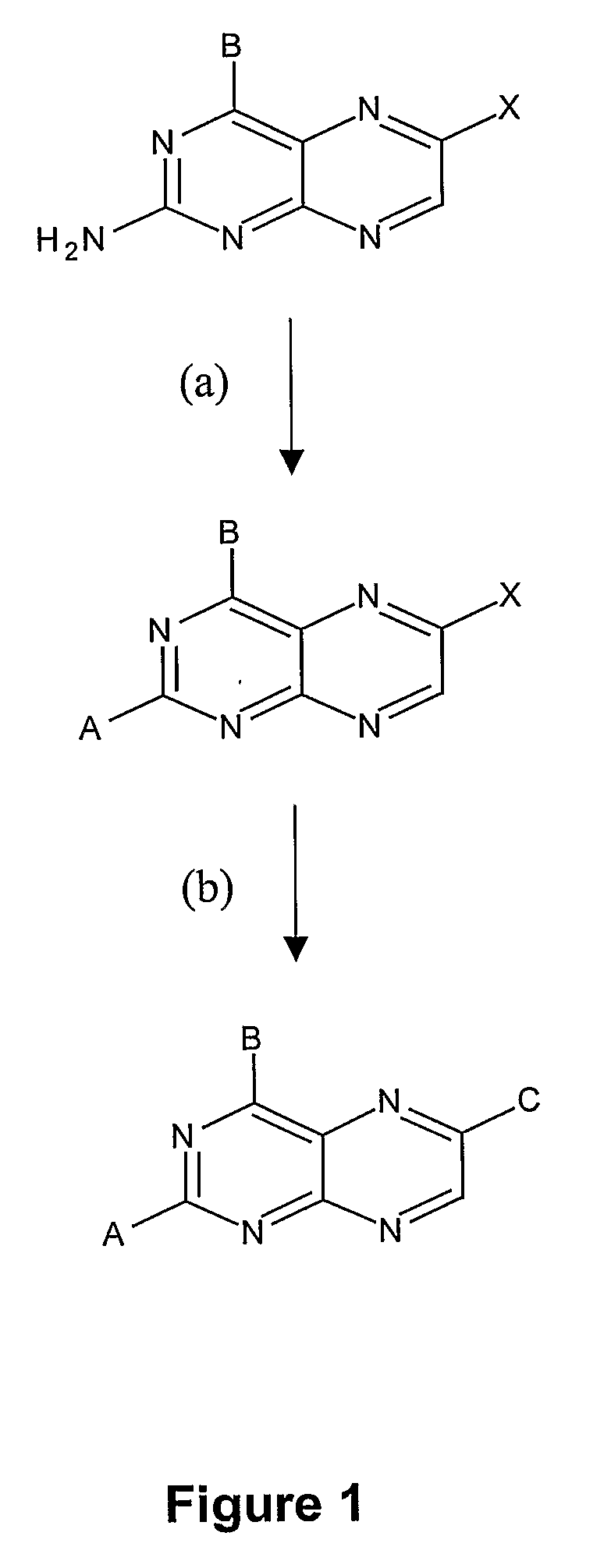Substituted pteridines for the treatment and prevention of viral infections
a technology of substituted pteridines and viral infections, which is applied in the direction of heterocyclic compound active ingredients, biocide, organic chemistry, etc., can solve the problems of inability to integrate hcv into the host's genome, inability to eradicate infection in most people, and inability to carry cirrhosis and/or liver cancer inchronic carriers, etc., to inhibit the replication of hepatitis c virus
- Summary
- Abstract
- Description
- Claims
- Application Information
AI Technical Summary
Benefits of technology
Problems solved by technology
Method used
Image
Examples
example b
Synthesis of 2-amino-4-[4-(4-methylphenyl)piperazinyl]-6-(4-isopropoxy-3-methoxy-phenyl)pteridine (Example 125, Table 1)
[0147]A purple suspension of 2,4-diamino-6-hydroxy-5-nitrosopyrimidine (5.05 g, 31.6 mmole) in water (80 ml) and NH4OH (6.4 ml of a 30% aqueous solution) was stirred at room temperature for 20 minutes. Then, sodium dithionite (16.6 g, 82 mmole, technical grade 86%) was added under vigorous stirring and the reaction mixture was stirred at 80° C. for 16 hours. The mixture was filtered while still hot, the filtrate was allowed to cool down to room temperature and then placed at 4° C. overnight. The precipitate formed was filtered off, washed respectively with cold water, methanol and diethyl ether, and dried to provide 2,4,5-triamino-6-hydroxy-pyrimidine (3.72 g, yield 83%) which was used as such for the following reactions.
[0148]To a suspension of 2,4,5-triamino-6-hydroxy-pyrimidine (17.2 mmole) and 4-acetoxy-3-methoxyphenylglyoxalmonoxime (2.43 g, 17.2 mmole) in met...
example c
Synthesis of 4-ethoxy-6-(4-fluorophenyl)-pteridin-2-yl]-(4-fluorobenzyl)-amine
[0150]
[0151]In a first step, a mixture of 6-chloro-4-ethoxy-pteridin-2-ylamine (50 mg, 0.22 mmol), 4-fluorobenzylaldehyde (85 μL, 0.88 mmol), trifluoroacetic acid (0.17 mL, 2.2 mmol) and NaBH(OAc)3 (140 mg, 0.66 mmol) in isopropyl acetate (1.5 mL) was heated to 120° C. for 30 minutes. After cooling, the reaction mixture was quenched by the addition of saturated aqueous NaHCO3. The solution was partitioned with ethyl acetate. The organic layer was dried over Na2SO4 and concentrated to afford the crude product which was purified by RP HPLC using a C18 column with a gradient of H2O, 0.05% TFA-acetonitrile, to provide (6-chloro-4-ethoxy-pteridin-2-yl)-(4-fluoro-benzyl)-amine as white solid (17 mg, yield: 23%) which was characterised as follows:
[0152]MS (m / z) 226.0 [M+H]+; and
[0153]HPLC Rt=1.72 min.
[0154]In a second step, a mixture of (6-chloro-4-ethoxy-pteridin-2-yl)-(4-fluoro-benzyl)-amine (17 mg, 0.05 mmol),...
example d
Synthesis of 4-{[6-(4-fluoro-phenyl)-4-(2,2,2-trifluoro-ethylamino)-pteridin-2-ylamino]-methyl}-benzenesulfonamide
[0158]
[0159]To a suspension of 4,5-Diamino-6-hydroxy-2-mercaptopyrimidine hemisulfate hydrate (15 g, 72 mmol) in water (200 mL) at 80° C. was added dropwise a solution of barium chloride dihydrate (8.8 g, 36 mmol) in water (100 mL). The resulting suspension was stirred for 30 minutes at 80° C. The reaction mixture was cooled to room temperature and barium sulfate was removed by filtration over diatomaceous earth. The filtrate was frozen and lyophilized to provide 9.22 g (66% yield) of 5,6-diamino-2-mercapto-pyrimidin-4-ol hydrochloride as beige solid.
[0160]To a boiling solution of 5,6-diamino-2-mercapto-pyrimidin-4-ol hydrochloride (1.22 g, 6.3 mmol) in methanol (60 mL) was added dropwise a solution of 4-fluorophenylglyoxal mono-oxime (1.08 g, 6.5 mmol) in methanol (10 mL). The reaction mixture was heated under reflux for 4 hours. The resulting precipitate was filtered, ...
PUM
| Property | Measurement | Unit |
|---|---|---|
| optical purity | aaaaa | aaaaa |
| optical purity | aaaaa | aaaaa |
| optical purity | aaaaa | aaaaa |
Abstract
Description
Claims
Application Information
 Login to View More
Login to View More - R&D
- Intellectual Property
- Life Sciences
- Materials
- Tech Scout
- Unparalleled Data Quality
- Higher Quality Content
- 60% Fewer Hallucinations
Browse by: Latest US Patents, China's latest patents, Technical Efficacy Thesaurus, Application Domain, Technology Topic, Popular Technical Reports.
© 2025 PatSnap. All rights reserved.Legal|Privacy policy|Modern Slavery Act Transparency Statement|Sitemap|About US| Contact US: help@patsnap.com



